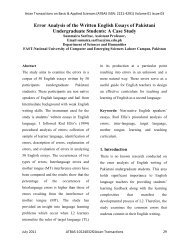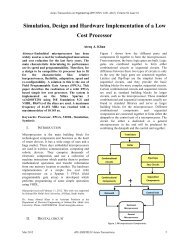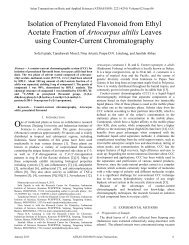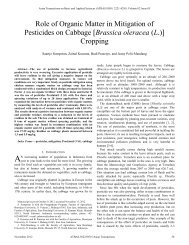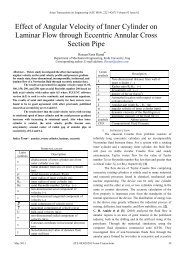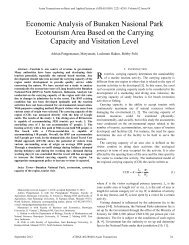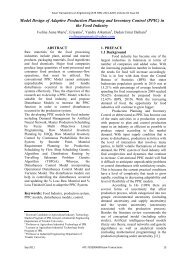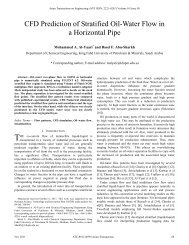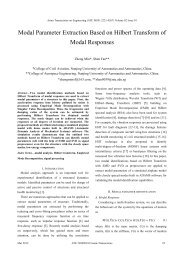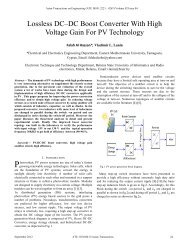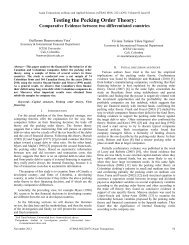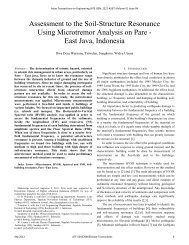Study the Photodegradation of Aniline Blue dye in aqueous Phase ...
Study the Photodegradation of Aniline Blue dye in aqueous Phase ...
Study the Photodegradation of Aniline Blue dye in aqueous Phase ...
Create successful ePaper yourself
Turn your PDF publications into a flip-book with our unique Google optimized e-Paper software.
Asian Transactions on Basic and Applied Sciences (ATBAS ISSN: 2221-4291) Volume 03 Issue 02O2-+ h+→ HO2Organic molecule +ecb-reduction products (7)HO , HO2 + organic compounds → degradation products (8)Semiconductor compounds have drawn much attention dur<strong>in</strong>g<strong>the</strong> last few years because <strong>of</strong> <strong>the</strong>ir novel optical and transportproperties which have great potential for many optoelectronicapplications. (7)Among <strong>the</strong> listed semiconductors, TiO 2 has proven to be <strong>the</strong>most suitable for widespread environmental applications. ZnOalso seems to be a suitable photocatalyst but it dissolves <strong>in</strong>acidic solutions it is a semiconductor material for variousphotonic and electrical applications. ZnO shows a unique set<strong>of</strong> physical and chemical properties, such as a wide band gap(3.2 eV), large exaction b<strong>in</strong>d<strong>in</strong>g energy (60 meV) at roomtemperature, radiation hardness (8) .T<strong>in</strong> dioxide (SnO 2 ) is a n-type semiconductor with a largeband gap (Eg = 3.9 eV ) which shows promise for a number <strong>of</strong>applications <strong>in</strong>clud<strong>in</strong>g transparent conductors.Z<strong>in</strong>c sulfide (ZnS) is a wide band gap and direct transitionsemiconductor (9) . Z<strong>in</strong>c sulfide is an important semiconductormaterial with a wide direct band gap Eg = 3.68 eV (10) .Dyes are typically organic compounds that absorblight <strong>in</strong> specific areas <strong>of</strong> <strong>the</strong> visible spectrum. <strong>Anil<strong>in</strong>e</strong> <strong>Blue</strong><strong>dye</strong> it is water soluble <strong>dye</strong> (11) , it is used for dy<strong>in</strong>g wool andcotton directly and widely used <strong>in</strong> <strong>dye</strong> <strong>in</strong>dustries <strong>the</strong>refore itspresence <strong>in</strong> <strong>the</strong> <strong>in</strong>dustrial discharge water also contributes toenvironmental pollution (12) . Due to its stability , it has longresidence time <strong>in</strong> water. (13) Molecular structure <strong>of</strong> <strong>Anil<strong>in</strong>e</strong><strong>Blue</strong> has been illustrated <strong>in</strong> Fig. 2. <strong>Anil<strong>in</strong>e</strong> <strong>Blue</strong>, also calledacid blue 22, ch<strong>in</strong>a blue, soluble blue 3M, and Mar<strong>in</strong>e blue. Itis very soluble <strong>in</strong> water,(6)<strong>in</strong>sulated <strong>in</strong> a wooden box to prevent <strong>the</strong> escape <strong>of</strong> harmfulradiation and m<strong>in</strong>imized temperature fluctuations caused bydraughts.Z<strong>in</strong>c oxide with 99% purity were supplied by Fluka-Garantie, Z<strong>in</strong>c sulfide with 99.3% purity supplied byM.B.LTD Dagenham and T<strong>in</strong> dioxide SnO 2 with 99% puritywas supplied by Fluka-Garantie . <strong>Anil<strong>in</strong>e</strong> blue <strong>dye</strong> (analyticalgrade) was purchased from (RDS-Hannover) and used withoutfur<strong>the</strong>r purification. Solutions were prepared us<strong>in</strong>g doubledistilled water. In all experiments, <strong>the</strong> required amount <strong>of</strong> <strong>the</strong>catalyst was suspended <strong>in</strong> 200 cm 3 <strong>of</strong> <strong>aqueous</strong> solutions <strong>of</strong>AB, us<strong>in</strong>g a magnetic stirrer. At predeterm<strong>in</strong>ed times; 5 cm 3 <strong>of</strong>reaction mixture was collected and centrifuged (3000 rpm, 15m<strong>in</strong>utes) <strong>in</strong> centrifuge. The supernatant was carefully removedby a syr<strong>in</strong>ge with a long pliable needle and centrifuged aga<strong>in</strong>at same speed and for <strong>the</strong> same period <strong>of</strong> time. This secondcentrifugation was found necessary to remove f<strong>in</strong>e particles <strong>of</strong>catalysts. After <strong>the</strong> second centrifugation <strong>the</strong> absorbance at(309, 586) nm <strong>of</strong> <strong>the</strong> supernatants was determ<strong>in</strong>ed us<strong>in</strong>gultraviolet-visible spectrophotometer, type UV-1650pc.P.D.E. <strong>of</strong> AB was followed spectrophotometrically by acomparison <strong>of</strong> <strong>the</strong> absorbance, at specified <strong>in</strong>terval times, witha calibration curve accomplished by measur<strong>in</strong>g <strong>the</strong>absorbance, at(λ max 586) nm, with different concentrations <strong>of</strong><strong>the</strong> <strong>dye</strong> solution.%Decolorization = 100 × (C 0 − C)/C 0where C 0 = <strong>in</strong>itial concentration <strong>of</strong> <strong>dye</strong> solution, C =concentration <strong>of</strong> <strong>dye</strong> solution after photoirradiation. In order todeterm<strong>in</strong>e <strong>the</strong> effect <strong>of</strong> catalyst load<strong>in</strong>g, <strong>the</strong> experiments wereperformed by vary<strong>in</strong>g catalyst concentration from 0.05 to 1.5 gfor <strong>dye</strong> solutions <strong>of</strong> 100ppm at natural pH (5.57). Similarexperiments were carried out by vary<strong>in</strong>g <strong>the</strong> pH <strong>of</strong> <strong>the</strong> solution(pH 2–12) and concentration <strong>of</strong> <strong>dye</strong>(25,50,100 )ppm. <strong>the</strong>reaction temperatures amounted to 293,303,313 and 323K.Fig. 2. structure <strong>of</strong> <strong>Anil<strong>in</strong>e</strong> <strong>Blue</strong> <strong>dye</strong> (14) .<strong>Anil<strong>in</strong>e</strong> <strong>Blue</strong> <strong>dye</strong> is a acidic <strong>dye</strong> belongs to triphenylmethane class <strong>of</strong> <strong>dye</strong> (15) Triphenylmethane <strong>dye</strong>s are those <strong>dye</strong>s<strong>in</strong> which a central carbon atom is bonded to two benzene r<strong>in</strong>gsand one p-qu<strong>in</strong>oid group (chromophore) (16) . The auxochromesare - NH 2 , NR 2 and –OH (17) . Triphenylmethane <strong>dye</strong>s are usedextensively <strong>in</strong> <strong>the</strong> textile <strong>in</strong>dustries for <strong>dye</strong><strong>in</strong>g <strong>of</strong> nylon,polyacrylon nitrile, modified nylon, wool, silk and cotton.3. RESULTS AND DISCUSSION3.1. UV–vis spectra <strong>of</strong> <strong>dye</strong>Results <strong>of</strong> <strong>the</strong> present study clearly show that <strong>the</strong>photocatalytic treatment <strong>of</strong> <strong>aqueous</strong> solution <strong>of</strong> anil<strong>in</strong>e blueunder UV light, leads to decolorization and degradation <strong>of</strong><strong>dye</strong>. Figs.3 to 5 shows <strong>the</strong> typical time dependent UV-Visspectrum <strong>of</strong> AB solution dur<strong>in</strong>g photoirradiation with ZnO,ZnS andSnO 2 respectively. The rate <strong>of</strong> degradation wasrecorded with respect to <strong>the</strong> change <strong>in</strong> <strong>the</strong> <strong>in</strong>tensity <strong>of</strong>absorption peak <strong>in</strong> ultraviolet region and visible region. Theprom<strong>in</strong>ent peaks were observed at λ max (309,586) nm whichdecreased gradually and f<strong>in</strong>ally disappeared <strong>in</strong>dicat<strong>in</strong>g (18) that<strong>the</strong> <strong>dye</strong> had been degraded.2. EXPERIMENTALA homemade photoreactor equipped with a Philips 250W,medium pressure mercury lamp as a source for UV radiation,was used to determ<strong>in</strong>e P.D.E. The reactor was consisted <strong>of</strong>graduated 1000 cm 3 Pyrex glass beaker and a magnetic stirr<strong>in</strong>gsetup. The lamp was positioned perpendicularly above <strong>the</strong>beaker. The distance between <strong>the</strong> lamp and <strong>the</strong> graduatedPyrex glass was 15 cm. The whole photocatalytic reactor wasMay 2013 ATBAS-80314020©Asian Transactions 24



